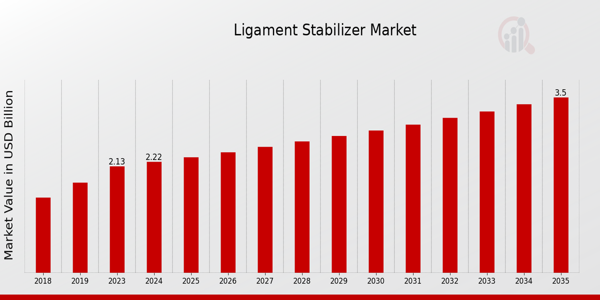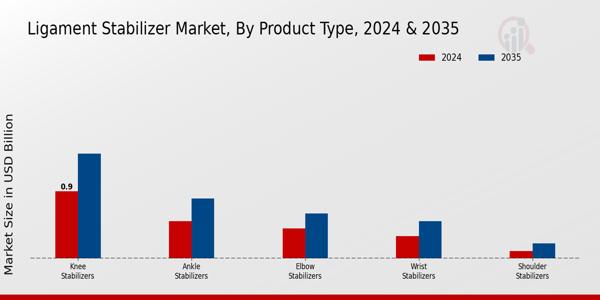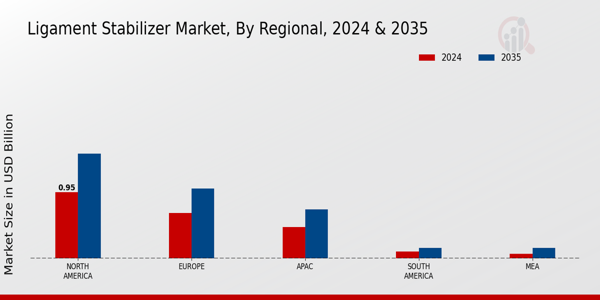Ligament Stabilizer Market Overview
As per MRFR analysis, the Ligament Stabilizer Market Size was estimated at 2.13 (USD Billion) in 2023. The Ligament Stabilizer Market Industry is expected to grow from 2.22(USD Billion) in 2024 to 3.5 (USD Billion) by 2035. The Ligament Stabilizer Market CAGR (growth rate) is expected to be around 4.24% during the forecast period (2025 - 2035).
Key Ligament Stabilizer Market Trends Highlighted
The Global Ligament Stabilizer Market is growing as a result of various factors such as increased participation in sports, prevalence of orthopedic injuries, and the ever-increasing aging population. Their need for effective joint support has also fueled the market. Collection of materials into more comfortable and pliable structures enhances the scope for market expansion. Moreover, increased knowledge on sports medicine boosts the use of ligament stabilizers for injury prevention. Demand for such stabilizers is also on the rise as the active population becomes more conscious about injuries. This market expansion is further supported by the change in focus by health care providers towards prevention, rehabilitation, and recovery products.
Expansion in the Global Ligament Stabilizer Market is indeed possible. The increased adoption of e-commerce has made it easier to sell orthopedic supports by opening online sales. In addition, regional diversification in developing countries will enable expanding the market in areas with low awareness of sports medicine. Cooperation between the manufactures and healthcare providers can result in products that are both useful in those defined markets and appealing to consumers. Also, reducing the capital burden of medical devices onto users, integrating smart technology into the ligament stabilizers will provide the consumer with real-time feedback regarding the stability provided.
Estimates reveal that there has been a bias towards tailored and specialized supportive solutions. The rise in demand for personalized orthopedic braces is linked to the increased consumer preference for products customized as per the individual’s requirements. Eco-friendly materials are popular with the health-conscious consumers, due to their concerns for sustainability. The concern of incorporating technology into fitness and wellbeing products is also gathering steam, with smart ligament stabilizers being more useful than the traditional ones. Overall, the Global Ligament Stabilizer Market, is set for further transformation as it responds to changing consumer expectations, new technology, and advancement in health care.

Source: Primary Research, Secondary Research, MRFR Database and Analyst Review
Ligament Stabilizer Market Drivers
Increasing Incidence of Sports Injuries
The rising participation in sports and physical activities around the globe is a significant driver for the Global Ligament Stabilizer Market Industry. More people are now engaging in recreational and competitive sports, which increases the risk of ligament injuries such as ACL (anterior cruciate ligament) tears and sprains. These injuries often require stabilization products for effective management and recovery, leading to a higher demand for ligament stabilizers.As awareness of injury prevention and recovery strategies grows among athletes and fitness enthusiasts, the demand for innovative and effective stabilization solutions is expected to witness substantial growth. Long-term, this trend will likely be complemented by advancements in product design and materials that provide enhanced support and comfort during physical activity. Educational initiatives focused on injury prevention in sports further underscore the need for ligament stabilizers, facilitating market growth.Therefore, the increasing incidence of sports injuries significantly influences the Global Ligament Stabilizer Market Industry, providing opportunities for manufacturers to innovate and expand their offerings to a broader audience.
Rising Elderly Population
The global increase in the elderly population plays a crucial role in driving the Global Ligament Stabilizer Market Industry. As individuals age, they become more susceptible to arthritis, osteoporosis, and other conditions that affect joint stability and mobility. Consequently, this demographic requires various support solutions, including ligament stabilizers, to maintain an active lifestyle and manage pain. Given the growing aging population, the demand for ligament stabilizers tailored for older adults is expected to rise, thus propelling market growth.Additionally, with increased focus on senior wellness and rehabilitation, there is a growing need for specialized products that help improve the quality of life for the elderly.
Technological Advancements in Product Development
Ongoing technological advances in the design and manufacturing of ligament stabilizers are significantly boosting the Global Ligament Stabilizer Market Industry. Innovations such as the use of lightweight and breathable materials, smart textiles that offer more effective compression, and customizable products tailored to individual needs have broadened the appeal of ligament stabilizers. These advancements not only improve the functional effectiveness of the products but also enhance user comfort, making them more attractive to a wider range of consumers.With an increasing focus on research and development, manufacturers are continually seeking ways to integrate novel technologies and materials that can offer improved performance and meet the evolving needs of consumers.
Ligament Stabilizer Market Segment Insights:
Ligament Stabilizer Market Product Type Insights
The Global Ligament Stabilizer Market is a vital segment of the healthcare industry, particularly focusing on the Product Type, which includes various kinds of stabilizers such as Knee Stabilizers, Ankle Stabilizers, Elbow Stabilizers, Wrist Stabilizers, and Shoulder Stabilizers. In 2024, the market is projected to be valued at approximately 2.22 USD Billion, demonstrating the growing demand for these products due to the increasing prevalence of sports injuries, arthritis, and other musculoskeletal disorders. Among these product types, Knee Stabilizers hold a significant market position, with a valuation of 0.9 USD Billion in 2024, expected to rise to 1.4 USD Billion by 2035. This growth can be largely attributed to the high incidence of knee injuries, particularly in athletics, making knee braces essential for recovery and rehabilitation.
Moreover, Ankle Stabilizers follow closely behind, valued at 0.5 USD Billion in 2024 and anticipated to grow to 0.8 USD Billion by 2035, marking them as a key component of this market due to the commonality of ankle sprains and the need for support during physical activities. Elbow Stabilizers are also noteworthy, with a market value of 0.4 USD Billion in 2024 and expected to rise to 0.6 USD Billion by 2035; they are becoming increasingly popular for players involved in racket sports, contributing to their steady growth. Wrist Stabilizers are viewed as essential for anyone dealing with repetitive strain injuries or acute trauma, which is reflected in their valuation of 0.3 USD Billion in 2024, with projections of reaching 0.5 USD Billion by 2035. Finally, Shoulder Stabilizers, although holding the lowest market share at 0.1 USD Billion in 2024, are anticipated to grow to 0.2 USD Billion by 2035, owing to increased awareness of shoulder injuries in sports and the need for effective rehabilitation solutions. A clear insight from the Global Ligament Stabilizer Market data reflects a majority holding in the knee and ankle stabilizers, underscoring their application in everyday life and sports, further driving innovations and product development. Market growth in this industry is not only fostered by increased participation in sports and fitness activities but also by an aging population more prone to injuries, establishing a continuous demand for effective ligament support.
As a result, industry players are meta-focusing on expanding their portfolios in these stability products, which could present a range of opportunities while balancing challenges such as competitive pricing and quality differentiation in an evolving market landscape. The Global Ligament Stabilizer Market statistics project a promising future influenced by both user-centric and clinical developments aimed at enhancing rehabilitative outcomes for various injuries.

Source: Primary Research, Secondary Research, MRFR Database and Analyst Review
Ligament Stabilizer Market Material Insights
The Global Ligament Stabilizer Market reflects a robust growth trajectory, particularly within the Material segment, expected to attain a valuation of 2.22 billion USD by 2024. This segment encompasses various materials such as Neoprene Foam, Cotton, Nylon, Spandex, and Polyester, each playing a significant role in the market landscape. Neoprene is notable for its durability and flexibility, making it a preferred material for high-performance stabilizers. Cotton offers breathability and comfort, thus appealing to a segment focused on user comfort during recovery.Nylon is often chosen for its strength and lightweight properties, while Spandex adds stretch and ease of movement, enhancing user experience. Polyester, known for its resistance to stretching and shrinking, also finds its place in many products. The diverse characteristics of these materials drive their adoption across different applications within the Global Ligament Stabilizer Market, guiding user preferences and shaping market trends. As consumer awareness regarding injury prevention and rehabilitation grows, the demand for high-quality materials in ligament stabilizers is likely to stay strong, underscoring the importance of this sector in the overall Global Ligament Stabilizer Market revenue.
Ligament Stabilizer Market Application Insights
The Global Ligament Stabilizer Market, projected to be valued at 2.22 USD Billion in 2024, showcases a diverse range of applications that cater to various needs in the healthcare domain. One of the prominent applications within this market is addressing sports injuries, which significantly drive demand due to the increasing participation in competitive athletics and recreational sports. Alongside, post-surgery recovery remains crucial as patients rely on ligament stabilizers to aid their rehabilitation and regain mobility. Chronic conditions also contribute a considerable share to the market, as these conditions often require long-term support and management, fostering a consistent need for stabilization products.Preventive care plays a vital role as well, with individuals seeking out ligament stabilizers to prevent injuries before they occur, especially in high-risk activities. Together, these applications reflect the dynamic nature of the Global Ligament Stabilizer Market, highlighting how varying consumer needs and a growing focus on health and fitness are shaping market growth and opportunities.
Ligament Stabilizer Market Distribution Channel Insights
The Global Ligament Stabilizer Market has witnessed significant growth across various distribution channels, with the market valued at 2.22 billion USD in 2024. The segmentation of this market includes Online Retail, Pharmaceutical Stores, Specialty Stores, Hospitals, and Clinics, each playing a vital role in providing access to ligament stabilizers. Online Retail has increasingly gained popularity due to its convenience and wide reach, appealing to consumers looking for hassle-free purchasing options. Pharmaceutical Stores also contribute significantly to the market, serving as primary points for consumers seeking professional advice alongside their purchases.Specialty Stores cater to specific needs and often carry specialized products that attract health-conscious customers. Meanwhile, Hospitals and Clinics are essential for the distribution of ligament stabilizers, particularly for post-surgical recovery, where medical professionals endorse the products. The diverse distribution channels ensure that the Global Ligament Stabilizer Market meets varied customer demands, highlighting the importance of accessibility and professional guidance in enhancing consumer confidence and market growth.
Ligament Stabilizer Market Regional Insights
The Global Ligament Stabilizer Market shows substantial valuation differences across various regions, highlighting distinct market dynamics and growth potential. In 2024, North America holds a majority share with a market valuation of 0.95 USD Billion, projected to rise to 1.5 USD Billion by 2035, significantly fueled by advanced healthcare infrastructure and increasing sports-related injuries. Europe follows with an initial value of 0.65 USD Billion in 2024, growing to 1.0 USD Billion, indicating a steady demand for orthopedic solutions driven by a rising aging population and increased awareness of joint health.The APAC market, valued at 0.45 USD Billion in 2024, is expected to reach 0.7 USD Billion, supported by a growing middle class and enhanced access to healthcare services. Both South America, starting at 0.1 USD Billion, and the MEA region, beginning at 0.07 USD Billion, show lower valuations but exhibit potential for growth due to increasing investments in healthcare infrastructure and rising incidences of sports injuries. Overall, North America significantly dominates, benefiting from technological advancements and higher consumer spending on healthcare services, while other regions present opportunities for expansion as market trends evolve and healthcare access improves.

Source: Primary Research, Secondary Research, MRFR Database and Analyst Review
Ligament Stabilizer Market Key Players and Competitive Insights:
The Global Ligament Stabilizer Market has been experiencing notable growth due to rising awareness about sports injuries, increasing participation in physical activities, and a demand for effective rehabilitation solutions. This market is characterized by competitive dynamics where various market players are making significant advancements in technology and product development. Companies are focusing on introducing innovative products that cater to specific needs of patients recovering from ligament injuries, including braces, wraps, and other support systems. The continuous evolution of materials and design in ligament stabilizers also plays a crucial role in enhancing the user experience and ultimately improving patient outcomes. Competitive strategies such as collaborations, mergers, acquisitions, and partnerships are being employed by market leaders to strengthen their market position and expand their product offerings.Medi US has established a strong presence in the Global Ligament Stabilizer Market through the robust quality and innovative design of its products. The company is known for its commitment to improving patient comfort and mobility, which is reflected in its range of flexible and protective stabilization solutions.
Medi US utilizes advanced materials and technology to ensure that their products not only provide adequate support but also promote healing while minimizing discomfort. This focus on healthcare outcomes makes Medi US a formidable player in this competitive landscape, as the company understands the nuances of injury prevention and rehabilitation, positioning itself as a trusted name for both healthcare professionals and patients alike.B. Braun has garnered recognition within the Global Ligament Stabilizer Market for its dedication to product quality and patient safety. The company boasts a comprehensive range of ligament stabilizers designed to meet the diverse needs of various user demographics, from athletes to individuals recovering from surgery. B. Braun emphasizes research and development to ensure that their products align with current clinical practices and advancements in orthopedic care. By focusing on collaboration with healthcare institutions and continuous feedback from users, B. Braun continues to enhance its offerings, making strides in technology that prioritize effectiveness, ease of use, and patient compliance. Its established network and strong brand identity contribute significantly to its competitive advantage in the market.
Key Companies in the Ligament Stabilizer Market Include:
Medi US
B. Braun
Thermo Fisher Scientific
Smith and Nephew
DePuy Synthes
Zimmer Biomet
Hanger
Stryker
Ottobock
Coloplast
Kinetisense
Conmed
DJO Global
Acelity
Medtronic
Ligament Stabilizer Market Industry Developments
Recent developments in the Global Ligament Stabilizer Market reveal significant activity among key players, particularly Medi US, B. Braun, Thermo Fisher Scientific, Smith and Nephew, DePuy Synthes, Zimmer Biomet, Hanger, Stryker, Ottobock, Coloplast, Kinetisense, Conmed, DJO Global, Acelity, and Medtronic. These companies are experiencing growth in market valuation, driven by an increasing demand for innovative orthopedic solutions and advancements in medical technology. Current affairs signal strategic initiatives, with companies focusing on enhancing product offerings and expanding their market presence through research and development investments. Notably, recent mergers and acquisitions have reshaped competitive dynamics, as firms seek to leverage synergies for improved product portfolios and market penetration. Such consolidations are often regarded as essential for innovation and efficiency within the sector, fostering collaboration across various specialties in medical devices. The overall market reflects a robust trajectory, supported by a growing emphasis on patient-centered care and rehabilitation solutions, which are critical to addressing the rising incidence of musculoskeletal disorders worldwide.
Ligament Stabilizer Market Segmentation Insights
Ligament Stabilizer Market Product Type Outlook
- Knee Stabilizers
- Ankle Stabilizers
- Elbow Stabilizers
- Wrist Stabilizers
- Shoulder Stabilizers
Ligament Stabilizer Market Material Outlook
- Neoprene
- Cotton
- Nylon
- Spandex
- Polyester
Ligament Stabilizer Market Application Outlook
- Sports Injuries
- Post-Surgery Recovery
- Chronic Conditions
- Preventive Care
Ligament Stabilizer Market Distribution ChannelOutlook
- Online Retail
- Pharmaceutical Stores
- Specialty Stores
- Hospitals and Clinics
Ligament Stabilizer Market Regional Outlook
- North America
- Europe
- South America
- Asia Pacific
- Middle East and Africa
| Attribute/Metric Source: |
Details |
| MARKET SIZE 2023 |
2.13 (USD Billion) |
| MARKET SIZE 2024 |
2.22 (USD Billion) |
| MARKET SIZE 2035 |
3.5 (USD Billion) |
| COMPOUND ANNUAL GROWTH RATE (CAGR) |
4.24% (2025 - 2035) |
| REPORT COVERAGE |
Revenue Forecast, Competitive Landscape, Growth Factors, and Trends |
| BASE YEAR |
2024 |
| MARKET FORECAST PERIOD |
2025 - 2035 |
| HISTORICAL DATA |
2019 - 2024 |
| MARKET FORECAST UNITS |
USD Billion |
| KEY COMPANIES PROFILED |
Medi US, B. Braun, Thermo Fisher Scientific, Smith and Nephew, DePuy Synthes, Zimmer Biomet, Hanger, Stryker, Ottobock, Coloplast, Kinetisense, Conmed, DJO Global, Acelity, Medtronic |
| SEGMENTS COVERED |
Product Type, Material, Application, Distribution Channel, Regional |
| KEY MARKET OPPORTUNITIES |
Growing sports injury prevalence, Rising geriatric population, Advancements in material technology, Increasing consumer awareness on joint health, Expanding e-commerce platforms for sales |
| KEY MARKET DYNAMICS |
rising sports injuries incidence, increasing demand for orthopedic treatments, advancements in medical technology, growing geriatric population, awareness of preventive healthcare |
| COUNTRIES COVERED |
North America, Europe, APAC, South America, MEA |
Frequently Asked Questions (FAQ) :
The Global Ligament Stabilizer Market is expected to be valued at 2.22 USD Billion in 2024.
By 2035, the Global Ligament Stabilizer Market is anticipated to reach a value of 3.5 USD Billion.
The market is expected to grow at a CAGR of 4.24% from 2025 to 2035.
North America is projected to hold the largest market share, valued at 0.95 USD Billion in 2024.
The European Ligament Stabilizer Market is expected to reach 1.0 USD Billion in 2035.
Knee Stabilizers are valued at 0.9 USD Billion in the Global Ligament Stabilizer Market in 2024.
Key players in the market include Medi US, B. Braun, Thermo Fisher Scientific, Smith and Nephew, and DePuy Synthes among others.
Ankle Stabilizers are projected to be valued at 0.8 USD Billion in 2035.
Key trends include increasing awareness of sports injuries and advancements in orthopedic technologies.
Shoulder Stabilizers are expected to be valued at 0.1 USD Billion in 2024.
















